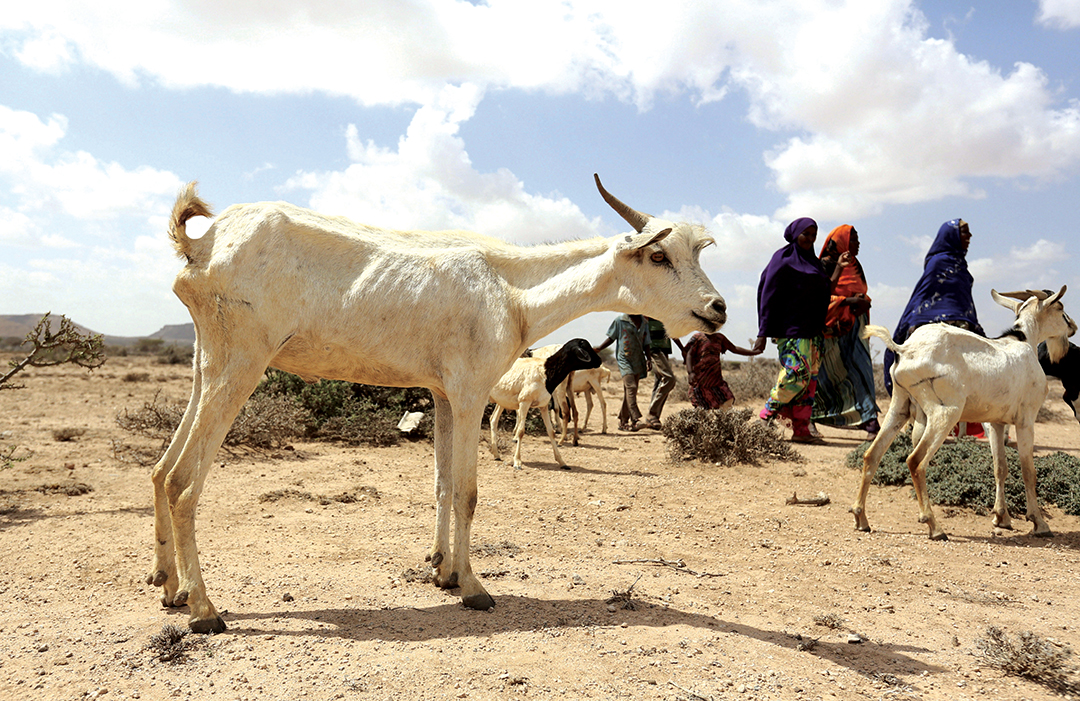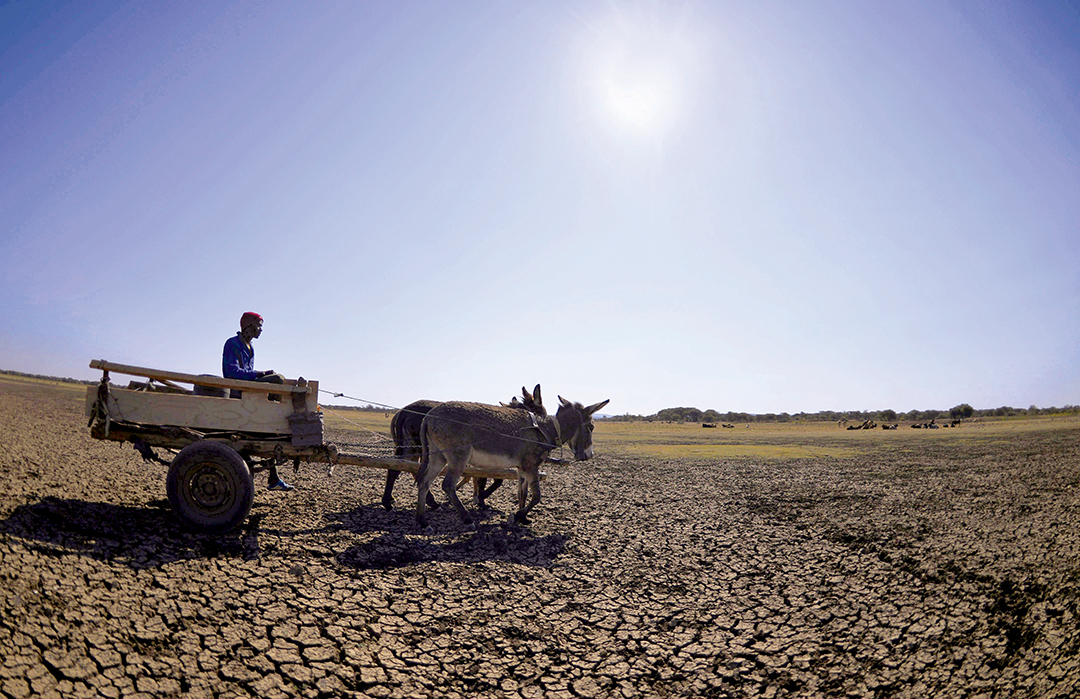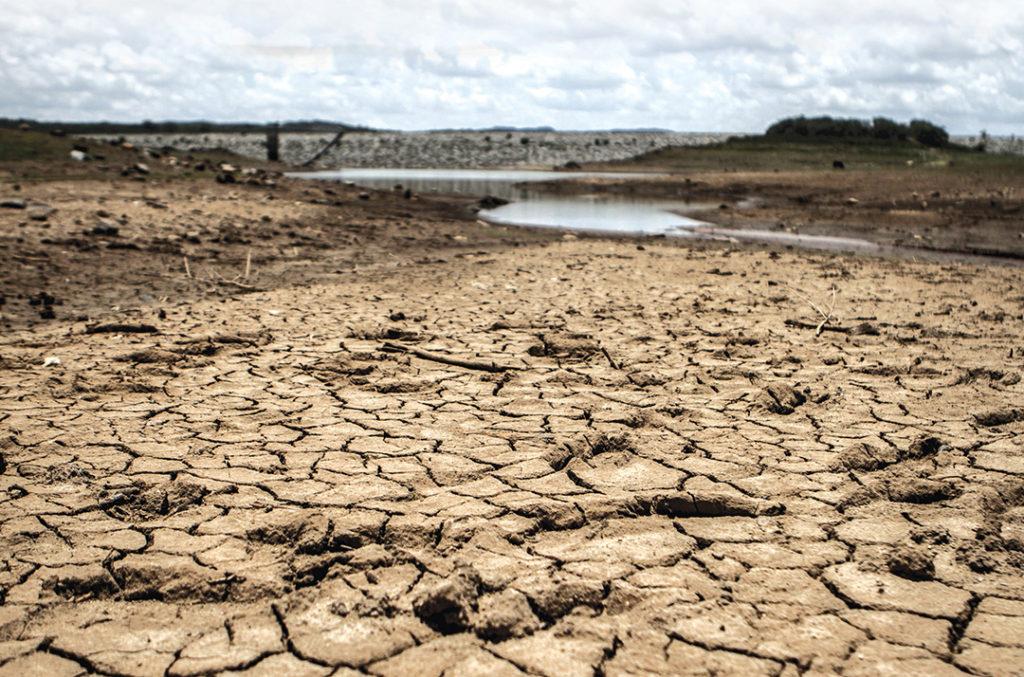Climate Change Can Combine With Other Factors to Affect Human Security
ADF STAFF
The profound and dangerous effects of climate change in Africa are nowhere more evident than in the ongoing conflict in Darfur. The raging war in the western region of Sudan often is oversimplified as a long-standing ethnic dispute between nomadic Arab herders and black African farmers.
Author Harald Welzer promotes a more complicated explanation, one that is “closely bound up with ecological problems.”
In his 2008 book, Climate Wars: Why People Will Be Killed in the 21st Century, Welzer detailed a diverse and intricate pattern of events that can be traced back to at least 1984, when an extensive drought and famine hit the region.

To cope with the drought, “the sedentary farmers tried to protect their meagre harvests by blocking access to their fields by ‘Arabs’ whose pastureland had dried up,” Welzer wrote. “As a result, the nomads were unable to use their traditional marahil, or herding routes and feeding places. … Here we see quite clearly that climate-induced changes were the starting point for the conflict.”
As usual, climate-related events either caused or were exacerbated by other conditions. The drought in Western Sudan caused tens of thousands of people to migrate because of a lack of food. Concurrent population growth heightened the overuse of land and resources. Welzer cited a 2007 United Nations Environment Programme study that said excessive population growth and environmental stressors combined to frame the violence between “Africans” and “Arabs.”
“So, conflicts that have ecological causes are perceived as ethnic conflicts, including by the protagonists themselves,” Welzer wrote. “The social decline is triggered by ecological collapse, but this is not seen by most of the actors.”
It is for this reason that Darfur has been called the first climate war. According to some scholars, climate will mix with other drivers such as poverty, economics and bad governance to drive conflict in Africa for years to come unless something is done.
TEMPERATURE AS A DRIVER OF CONFLICT
In recent years, new studies have shown that climate change may be influencing human behavior — in a violent way.
In a 2009 paper, “Warming increases the risk of civil war in Africa,” scholars Marshall Burke, Edward Miguel, Shanker Satyanath, John A. Dykema and David B. Lobell found “strong historical linkages between civil war and temperature in Africa.”
When looking at climate model predictions of temperature trends, the researchers found that the “historical response to temperature suggests a roughly 54% increase in armed conflict incidence by 2030, or an additional 393,000 battle deaths if future wars are as deadly as recent wars.”
They call on African governments and foreign donors to reform policies to deal with temperature increases.
The study’s numbers are stark and dramatic, but they don’t necessarily tell the entire story, according to the University of Colorado’s John O’Loughlin. The relationship between climate and conflict is much more complicated, he says.
Several years after the 2009 paper, O’Loughlin, a professor of geography, led a team of researchers that examined more than 78,000 armed conflicts between 1980 and 2012 in the Sahel region, which stretches 3,000 miles from the Atlantic to the Indian Ocean. Although researchers found that higher temperatures in the Sahel increase conflict risk over time, several other factors typically were more influential than climate.

O’Loughlin’s study, and separate research by Ngonidzashe Munemo, a political science professor at Williams College who is originally from Zimbabwe, indicate that climate change is one of several variables that combine to produce insecurity among populations. These variables can include the quality of governance, racial and ethnic relations, and socio-economic conditions, among other things. Climate alone is unlikely to produce conflict, they say, but it can tip the balance toward unrest.
“If a government has relatively little resources to distribute and favors its own group, or its own region, and it basically discriminates against or ignores other areas that essentially are not part of their political group, then it does raise the risk of conflict,” O’Loughlin said. So what is happening in the Sahel is a kind of “multiplier effect of higher temperatures combined with these other factors that we know are strongly related to the risk of violence.”
GETTING AHEAD OF CLIMATE EVENTS
There is an old saying that “everybody talks about the weather, but nobody does anything about it.” Humankind has struggled with the unpredictability and ferociousness of singular weather events and long-term shifts in climate for thousands of years.
Violence is just one potential result from climate change in Africa. The phenomenon also has the power to increase poverty. A 2015 World Bank report says climate change will push more than 100 million into poverty between now and 2030. Asia and Sub-Saharan Africa could be the hardest-hit regions.
However, as global climate change slowly edges average temperatures higher, other, more cyclical, climate patterns will continue to place a strain on many African nations. This was especially evident in East Africa and Southern Africa as El Niño held the region in the grip of severe drought and food insecurity.
El Niño, a regular event characterized by unusually high temperatures in the Equatorial Pacific, can bring drought to some regions and seemingly unceasing rain to others. The 2015 iteration was the worst in 35 years, and it has been wreaking havoc in Africa for months.
The United Nations World Food Programme (WFP) said in February 2016 that El Niño could affect up to 49 million people in Southern Africa, where 14 million already faced hunger. The region was seeing its lowest rainfall since 1981.
In East Africa, nearly 20 million people faced critical food insecurity in March 2016, according to the United Nations. In Ethiopia alone, 2.2 million children under 5, nursing mothers and pregnant women would need treatment for moderate acute malnutrition in 2016, WFP said. That’s more than twice the number from 2015.
Drought — regardless of whether it’s caused by El Niño — and resulting famines require swift, decisive action to avoid humanitarian disasters. Munemo, of Williams College, said two Southern African countries have approached the problem in contrasting ways.
Zimbabwe, he said, typically has an ad-hoc approach when responding to climate crises. A presidential declaration is needed to mobilize the effort to mitigate hunger or other stressors. When the crisis is over, the response ends. When the next crisis occurs, officials must reinvent the wheel with regard to funding and forming a ministerial-level team to respond.

In neighboring Botswana, known for good governance and a lack of corruption, responsibilities have been built into the government’s ministerial framework and are always at the ready. The responses are actually part of government officials’ jobs.
“So if you are a drought-affected household in Zimbabwe and a drought-affected household in Botswana, in Zimbabwe you don’t know until that moment when the government says, ‘OK, we now recognize there’s a drought, and we’re going to do X’ — you don’t know,” Munemo told ADF. “In Botswana, you do know. You know that there is a standing commitment that in the event of a drought the government will respond. And second, you also know what they will do. So what Botswana did was to not just write the commitment that we will respond to drought, but here’s what the government will do. … So it removes that uncertainty.”
Botswana’s established procedures ease already-difficult logistical tasks, and they make aid harder to manipulate for the advantage of one group or region. Government interventions in Botswana include subsidies and partial forgiveness of loans to farmers, feeding programs for malnourished children, construction of barriers to prevent wildfires, and emergency water supply projects.
If the military has any role at all in responding to climate-related disasters, it might be best suited to help governments overcome the logistical challenges of securing and delivering food and other supplies to affected populations. In most African countries, the military is one of the few institutions with the experience and equipment to move things from place to place. Military and police forces also may be necessary to secure supplies in areas of unrest.

Even then, Munemo said, the military’s historical role in a country and how it is viewed by civilians must be considered. Having a partisan military involved in a response might be counterproductive. Government and military officials also must be mindful of the optics presented by having the military at the forefront of relief efforts.
In short, climate change is more of a human development issue than a military issue, O’Loughlin said. Good government and strong institutions can help nations mitigate the security threats posed when climate mixes with other stressors such as poverty, economics, geography and cultural differences.
AFRICA FILLS CLIMATE INFORMATION GAPS
One area where Africa has been weak, O’Loughlin said, is with regard to climatological networks across the continent. Africa has the worst continental land-based climate and weather network in the world. Detailed information is necessary to spot trends and changes in climate to establish appropriate responses and early warnings for crises. African officials have been working in recent years to collect and share information in hopes of building resilience to severe weather and to adapt to climate change.
The African Ministerial Conference on Meteorology (AMCOMET) was established in 2010 to provide leadership and policy guidance on weather information. African ministers convene every two years to discuss weather-related matters and how they relate to development. The World Meteorological Organization, working with the African Union Commission, is its secretariat. AMCOMET promotes political cooperation among member states, and the sharing of information to minimize the effects of climate change and extreme weather.
According to AMCOMET, weather and climate cause 90 percent of all disasters worldwide, claiming lives and stifling development. Between 1980 and 2010, nearly 10,000 disasters killed 2.5 million people and led to $1.3 trillion in economic losses.

AFP/GETTY IMAGES
Those losses can be reduced if populations and governments have timely access to reliable climate and weather information. For example, such information could be of particular benefit to farmers and pastoral communities seeking where, when and what to plant.
AMCOMET has approved the Integrated African Strategy on Meteorology to put weather and climate services at the center of national and regional development. The strategy focuses on five pillars, including increasing political support for and recognition of meteorological services; enhancing weather and climate services for development; and supporting services for climate change adaptation and mitigation.
Climate change has the potential to mix with existing human security stressors to tip the scales toward violence. But even as global temperatures increase, there is reason to be hopeful.
“The takeaway message is it’s not gloom and doom, a kind of unmitigated disaster that’s looming because of climate change,” O’Loughlin told ADF. “There’s a lot that can be done to head it off. And frankly, the best thing that could be done is to improve the nature of governance in Africa and to support democratic and fair regimes that don’t essentially discriminate against their own populations.”

